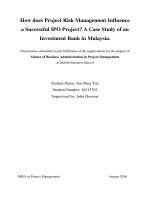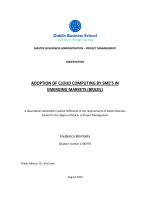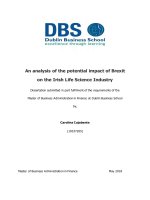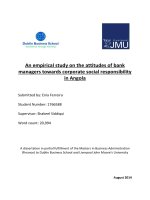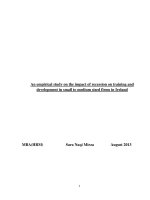Master Thesis in Economics: An examination of fiscal contraction in an open economy with fiscal and monetary restrictions, the case of Ireland
Bạn đang xem bản rút gọn của tài liệu. Xem và tải ngay bản đầy đủ của tài liệu tại đây (1.73 MB, 165 trang )
MASTER’S DISSERTATION
Austerity: An examination of fiscal contraction in an open economy with fiscal and monetary restrictions, the case of Ireland.
Submitted in partial fulfilment of the requirements of a Master’s Degree
(MBA) in Finance
BRENDAN MC HUGH
Dublin Business School
AUGUST 2013
Austerity: An examination of fiscal contraction in an open economy with
fiscal and monetary restrictions, the case of Ireland.
Author:
Brendan Mc Hugh
Student Number:
1682177
Supervisor:
Michael Kealy
Dublin Business School
AUGUST 2013
1
Declaration:
I declare that all the work in this dissertation, except where referenced, is entirely my own.
Those referenced are listed in the bibliography section at the end of this paper. This work or
no part of this work has previously been submitted for assessment to this or any other
institution.
Signed:………………………
Date:…………………
2
Table of Contents ....................................................................................................... 2
List of Figures and Tables ......................................................................................... 4
Acknowledgements ................................................................................................... 5
Abstract ..................................................................................................................... 6
1 Introduction ........................................................................................................ 7
1.1 Background and Context ............................................................................... 7
1.2 Aims and Objectives ..................................................................................... 9
1.3 Approach to the Research............................................................................ 10
1.4 Rstionale for the Research ........................................................................... 10
1.5 Organisation of Dissertation ...................... Error! Bookmark not defined.1
1.6 Research Limitations and Scope ............... Error! Bookmark not defined.2
2 Literature Review ............................................................................................. 14
2.1 Introduction ................................................................................................. 14
2.2 Austerity and the Fiscal Policy Debate ....................................................... 18
2.3 Austerity and Expansionary Fiscal Contraction .......................................... 21
2.4 Austerity Imposed on Ireland and the Socio-political Iinferences .............. 26
2.5 Taxation and Expenditure Adjustments and their Effects ........................... 29
2.6 Icelandic Recovery, Monetary Policies and a Flexible Exchange Rate ...... 32
2.7 Further Exploration of Flexible Ex/Rates and Currency Devaluation ........ 36
2.5 Fiscal Multiplier and How it is Affected by Fiscal Instruments .................. 40
3 Methodology ...................................................................................................... 45
3.1 Methods and Design .................................................................................... 45
3.2 Research Philosophy ................................................................................... 48
3.3 Research Approach ...................................................................................... 50
3.4 Research Strategy ........................................................................................ 51
3.5 Accessibilty ................................................................................................. 52
3.6 Research Choice .......................................................................................... 53
3.7 Time Horizon............................................................................................... 54
3.8 Sampling...................................................................................................... 55
3.9 Data Collection Methods ............................................................................. 57
3.10 Ethical Considerations ................................................................................. 59
3.11 Limitations................................................................................................... 61
4 Data Analysis and Findings ............................................................................. 63
2
4.1 Introduction ................................................................................................. 63
4.2 Austerity Conotations and implementation reasoning ................................ 65
4.3 Fiscal Contraction in a Shrinking Economy................................................ 68
4.4 Government Expenditure, Debt Levels and Taxation ................................. 70
4.5 Fiscal Multiplier in a Depressed Economy ................................................. 74
4.6 Ireland and Iceland; A Comparitive Analysis .............................................. 75
4.7 Socio-Political implications of Austerity .................................................... 78
4.8 Assessment of the Success or Failure of Austerity to Date ......................... 79
4.8 Conclusion ................................................................................................... 82
5 Conclusion and Recommendations ................................................................. 84
5.1 Conclusion ................................................................................................... 84
5.2 Limitations of the Research ......................................................................... 91
5.3 Recommendations ....................................................................................... 92
6 Reflection on Learning and Skill Development ............................................. 93
6.1 Introduction and Learning Styles ................................................................ 93
6.2 Time Management ....................................................................................... 98
6.3 Critical Thinking ......................................................................................... 99
6.4 Numeracy and quantitative skills .............................................................. 100
6.3 Future Application ..................................................................................... 101
Bibliography ........................................................................................................ 103
Appendices ........................................................................................................... 113
Appendix 1 Primary Research Interview Questions ........................................ 113
Appendix 2 Interview Guide ............................................................................ 115
Appendix 3 Interview Synopsis A .................................................................... 117
Appendix 4 Interview Synopsis B .................................................................... 126
Appendix 5 Interview Synopsis C .................................................................... 133
Appendix 6 Interview Synopsis D .................................................................... 139
Appendix 7 Interview Synopsis E .................................................................... 148
Appendix 8 Consent form ............................................................................... 158
Appendix 9 Soloman and Felder Learning Styles: Results .............................. 159
Appendix 10 Mumford and Honey Learning Styles: Questionnaire ................. 160
Appendix11 Mumford and Honey Learning Styles: Results ............................ 162
3
List of Tables and Charts
List of Figures
Figure 2.1: PIIGS Unemployment Comparison .................................................. 16
Figure 2.2: Irish Debt Compared to Eurozone Average ...................................... 25
Figure 2.3: Export/Import Comparison – Ireland ................................................ 39
Figure 2.4: IMF Forecast Errors .......................................................................... 44
Figure 3.1: Research Onion ................................................................................. 47
Figure 4.1: General Government Financial Balances .......................................... 66
Figure 4.2: Gross Federal Debt/GDP – US (War Time) ...................................... 73
Figure 4.3: General Government Deficit/GDP – Ireland..................................... 80
Figure 4.4: Ireland Government Debt/GDP ........................................................ 82
Figure 6.1: Kolb’s Learning Styles ...................................................................... 94
List of Tables
Table 1.1: Ireland Emigration/Migration 2010 - 2012 .......................................... 8
Table 2.1: Unemployment rate, EU and Eurozone .............................................. 15
Table 2.2: Government Spending, Deficits and GDP - Ireland and Iceland ........ 33
Table 2.3: Goods Trade Surplus Figures ............................................................. 40
4
Acknowledgements
A brief appreciation to those who assisted the author in the construction of this research
paper. Primarily one must recognise the practical guidance afforded to them from their
supervisor Michael Kealy, the ubiquitous feedback was always a source of encouragement.
The importance of the contribution made by the interview candidates cannot be overstated.
Their valuable time given and aptitude conveyed throughout, was truly gratifying. A thank you
to friends and colleagues for aiding in many various ways throughout this project. Also to the
Central Bank of Ireland for their support and facilitation when it was needed. Finally to a family
full of inspiration and the ever patient and heartening Emer, to you all a prodigious thank you.
5
Abstract
This research is both timely and of the utmost relevance, given that the implementation of austerity fiscal policies has impacted Irish society and its economy in the wake of a post financial crisis. It
has consequences for every household and its legacy will be measured by future generations.
Much debate has ensued surrounding the perceived necessity of such a drastic contractionary
policy. Yet no study has ultimately proven whether or not austerity will work for Ireland. The aims of
this research are: to establish the reasoning behind the implementation of austerity; how its elements
were used as instruments to improve fiscal balance sheets; did these policies have to be contractionary;
was there a viable alternative as in the case of Iceland- and it assesses the progress of austerity to date
in Ireland. Initially this research gets to the heart of that debate by understanding austerity and then
peeling back the theoretical layers of its components, and how these different measures of austerity
impact on an economy.
Through a method of qualitative interviews, the author was able to apply the economic theories and
opinions examined for secondary research to the case of Ireland. On application of these concepts, it
was found that a lot of the theory was simply that-theory, with little real life efficacy in an Irish context,
given the many limitations its government had at a time when drastic fiscal decisions had to be made.
This research also found that the Irish government of the day had little other choice than to implement
these contractionary policies, as Ireland was experiencing an unsustainable level of debt, combined with
a growing deficit and the reluctance of the bond markets to let them borrow. Ireland’s involvement in
the EU-IMF bailout- which proved necessary- and its membership of the Eurozone from which they
have prospered from in recent decades, proved to be major restricting factors in fiscal and monetary
policy decisions.
An important theory that should be acknowledged by Irish fiscal decision makers(which the
author found in the secondary research and was able to support through their primary research) is that
the raising of taxes has a more profoundly negative effect on an economy than cuts made to government
expenditure. In the conclusion, the researcher recognises the many adverse socio-political effects resulting from austerity- but highlights there are indications to show that austerity is being effective,
demonstrated by the sharp decline in the Irish budget deficit and its ability to return to the international
bond markets. These findings, however, may be immature as Ireland still finds itself in an EU-IMF
bailout situation, with a very high Debt/GDP ratio and a severe unemployment rate. Further research
will be required on this matter in the future in order for a conclusive verdict on the effectiveness of the
austerity fiscal policies.
6
Chapter 1 - Introduction
1.1 - Background and Context
It is becoming increasingly difficult to ignore Austerity in Ireland which has been
proffered as a panacea for the current financial crisis since its implementation by the Irish
government. It is a contentious and contemporary topic, with debate still ongoing regarding
appropriateness of austerity in an already floundering economy. Some contend –such as
Krugman (2011) - that austerity only compounds a country’s existing economic woes;
however, there are also diverging opinions -(ECB, 2010) and Plosser, (1989)- to say that fiscal
consolidation can bring benefits to an economy. The consequences of contracting an economy
can be felt by all. This is evident in the large numbers of both nationals and non-nationals
having to leave Irish shores in search of employment elsewhere (Figure 1.1) and the drastic
increase in the unemployment figures, which now sits at 14.7% (Figure 2.1). These
implications will have further economic consequences in the long term.
However, the focus of this research is to examine the economic aspects of fiscal
consolidation and to assess a viable alternative to austerity in an Irish context. This research
will also to a lesser extent consider the importance of the socio-political effects on Irish society
as a result of the introduction of austerity policies.
7
Ireland Emigration/Migration 2010 - 2012
Source: CSO
Table 1.1
Previous research has been conducted on the economic implications of austerity on an
economy; however, there is a lack of research in the case of Ireland and the limitations of a
country bound by the economic policy restraints of being a member of the Eurozone. The
argument that austerity is a waste of time and damaging has gathered ground in recent
times.Recent developments in the austerity debate have heightened the need for a more
rigorous analysis of its effects. An example of these developments is Rogoff and Reinhart’s
(2010) now infamous paper on the chances of an economy growing when experiencing high
debt to GDP levels which was recently debunked (Herndon, Ash and Pollin, 2013). This gave
plenty of ammunition to the anti-austerity activists to highlight the deficiencies of austerity and
to question the basis on which many governments based their austerity programmes. Although
the 2007/2008 crisis is the main reason for the need of fiscal austerity, it is not the author’s
intention to research the crisis, given that this topic has been covered exhaustively. It is
intended by the author to understand what austerity is, why is it needed, was it Ireland’s only
8
choice to balance their fiscal accounts, its implications and is there a viable alternative? To do
this, the writer will conduct secondary research on theory and opinion regarding the
implementation of austerity and its economic measures and conduct interviews to ascertain
how these theories can be applied to Irish economic problems.
1.2 - Aims and Objectives
The strenuous debate on the matter of austerity has shaped social unrest in Ireland albeit
not to the extent of other countries such as Greece and Italy. This unrest has somewhat
overshadowed the rudimentary economic reasoning that has been used to justify the use of
austerity. The researcher aims to highlight this economic reasoning for austerity. The rational
for such a study is that this topic is contemporary, ongoing and has a real life impact for all
Irish people on a daily basis, including the author.
The aim of this research is to move beyond the political and agenda based debate on
austerity and to understand the fiscal reasoning behind its implementation by the Irish
government- and to research whether there is a viable alternative to austerity. To achieve this,
the research will consult existing publications and papers on the matter, as well as interviewing
experts in relation to austerity and Ireland. To fulfill the research brief, the topics examined
(guided by research questions) in this paper are;
To understand what is meant by austerity;
To evaluate how the economical elements of austerity work in recessionary times;
To examine whether it is possible for Ireland to adjust their fiscal consolidation policies;
To evaluate whether Ireland could replicate the Icelandic recovery model.
9
It is the intention of the writer to be able to answer these questions after conducting both
the primary and secondary research which will be detailed in later chapters.
1.3 – Approach to the Research
The use of primary and secondary research will be used. Secondary research, through
analysis of existing articles, papers and academic publications, will be used to gain an
understanding of the main topics. This knowledge will help guide the researcher when
conducting the primary research through qualitative in-depth interviews. The knowledge
gained from this research will then be incorporated into setting the questions for the interview
candidates which will in turn become the author’s primary research. Interviews will be
employed to gain an understanding of austerity, how fiscal consolidation is being used by the
Irish government and whether there is a viable alternative to the austerity measures therein.
The author will then correlate both secondary and primary research in the conclusion.
1.4 - Rationale for the Research
The rationale for this research is that the topic of austerity is not merely of academic
interest; it directly affects almost every individual in Ireland, not only economically but also
socially. The Irish government, whose decisions are diminishing people’s disposable income
through increased taxation measures while reinvesting less into the economy through
10
expenditure, have made claims that austerity is the answer; however, there are arguments to
suggest otherwise. It is a topic therefore that professionals, academics and the public would be
interested in.
Saunders et al. (2009) tell us a dissertation subject must be of genuine interest and
within the capabilities of the researcher. The researcher is a finance graduate and works
professionally in the banking industry which illustrates their competences for the chosen
research topic. The writer works in Central Banking which has given them a genuine interest
in tackling this economically based conundrum.
The recipients of this research will be Dublin Business School and aimed towards the
business and economics communities, professionals, academics and students alike. This
research will shed light on Ireland’s fiscal decision making process since entering into the EUIMF bailout. It is an up-to-date topic so would also be useful to professionals such as bankers
and economists. Considering that these austerity policies employed by the government are
affecting every family in Ireland, this research would be welcomed in the public domain. The
results may also be useful to unions or groups opposed to or supportive of Irish fiscal policies.
The decision makers of Irish fiscal policies will also find the results of this research useful.
1.5 - Organisation of the Dissertation
This chapter (Chapter 1) will give the reader an understanding and background to what
the researcher is endeavoring to achieve with a synopsis of the paper. The succeeding chapter
(Chapter 2) will be based on analysis of existing research in articles and academic paper. This
11
will assist in equipping the author with a critical view of current theories and opinions
associated to austerity, fiscal consolidation, fiscal multiplier, Iceland’s economic recovery
model and other related topics. These areas of economics are chosen based on the most
dominant and reoccurring arguments discovered while researching the literature. The following
chapter (Chapter 3) will examine the methodology necessary in the process of conducting this
research paper. It describes the methodology process chosen by the writer, its application to
their particular project and justification for the methods and tools adopted. This process is
influenced by the research onion (Saunders et al, 2007). In Chapter 4, the author will analyse
the findings from data retrieved from in-depth interviews with selected economists and
bankers. This will make up the primary research section of the paper. The data collection
methods are explained therein. Chapter 5 will then present the researcher’s conclusions based
on the above mentioned findings and analysis. The author will then endeavour to answer the
research questions. In the final chapter (Chapter 6) the author will put forward a self-reflection
of their learning and development during the completion of the MBA in Finance. The
bibliography is composed of a list of articles, academic journals, books and websites referred
to during the research. All citations in the bibliography are not referenced in the main body as
some were used to gain a foundation of knowledge prior to and during the research which are
not directly related to it.
1.6 - Research Limitations and Scope
A major limitation to this research is that the primary research methodology of qualitative interviews can be deemed subjective data. Due to the nature of the research, expert views
are necessary in the context of the Irish economy, therefore there were a limited number of
appropriate candidates to interview. However, the author did attempt to negate agenda based
12
views when selecting these participants. It is acknowledged by the researcher that a larger pool
of interviewees may have produced a more balanced view, but due to time and resource manacles, a limited number had to suffice. Due to the part-time nature of this research, time constraints are very limiting. The process of conducting interviews is very time consuming given
that it consists of arranging interviews, conducting, transcribing and coding them. Also, adhering to good ethical research practice means confidentiality and consent forms must be written
up if necessary and authorization must be obtained in order to use the views of the candidates.
13
Chapter 2 - Literature Review
2.1 - Introduction
The Irish economy has been in an economic crisis for 5 years with record highs in
unemployment (14.7% in 2012), even compared to other EU nations. (See figure 2.1.)
However, if we compare Ireland to the other Eurozone countries of Portugal, Italy, Ireland,
Greece and Spain, (PIIGS) who have also encountered severe recessionary implications, we
see that Ireland has lower unemployment (14.7 %) than all but Italy in 2012(Figure 2.2). There
has been much new jargon associated with the financial crisis. Many terms are loosely thrown
around through media and social conversation such as bailouts, bond holders, Troika,
promissory notes to name but a few. However, the term ‘Austerity’ is the one that gets people’s
attention. Ask anybody on the street what is meant by austerity and they will say things like
less cash in their pockets, less jobs, domestic cutbacks, mortgage struggles and so on. They
generally know it as a term of negativity. This is a fiscal policy used by the Irish government
in an attempt to aid its economic recovery by way of cutting expenditure and increasing taxes.
This is a hot topic at the moment with rarely a day passing that there is not a reference to it in
national newspapers and other media.
Used in correct measures, austerity can be successful (Batini et al, 2012); however there
is much literature that suggests that austerity can be counterproductive (Pollin, 2010). There
are even opinions that claim fiscal policies are not the answer to recovering an economy but
that monetary policies are more effective (Friedman, 1986). Many critics more recently have
14
come out against the use of austerity (Black, 2013). In a recent speech in Dublin, Noam
Chomsky highlighted the consequences of economic austerity. He accuses the ECB of
imposing unfair and counterproductive measures on the people of Ireland. Ashoka Mody, the
former IMF mission chief to Ireland, has also come out against the use of austerity policies
(Crosbiea, 2013).He believes ‘the construct of Ireland’s rescue was wrong’.
It is the
researcher’s intention to study austerity, its components and alternatives.
Unemployment rate, EU and Eurozone 2001-2012
(Source: Eurostat)
Table 2.1
15
The alternative could be to have a more flexible exchange rate through monetary policy;
however, Ireland can’t achieve this while still a member of the Eurozone. Leaving the Euro
would give Ireland the opportunity to devalue the Irish currency for economic growth. This
question was discussed in Reuters recently (Salmon, 2010).In the article, it is suggested that it
may be a good idea for some of the weaker Eurozone members to exit for a period of time until
their economies become stronger and then re-join again. Tepper (2012) speaks about countries
that have previously left currency unions and prospered. He emphasises some break-ups from
the past which illustrate this principal such as the Austro-Hungarian Empire in 1919, India and
Pakistan 1947, Pakistan and Bangladesh 1971, Czechoslovakia in 1992-93, and USSR in 1992.
PIIGS Unemployment 2005 - 2012
(Source: Eurostat)
Figure 2.1
16
One does not have to look too far for commentary on austerity in today’s media. It
appears austerity is failing and more of its original advocates are beginning to agree. A recent
article by Dr Stephen Kinsella (2013) contends that austerity in the short term is killing the
SME’s in Ireland. He highlights the cuts in spending as a major problem for businesses that are
also having trouble getting credit from banks. Kinsella believes that austerity is not working.
His argument is that although not the solution to all Ireland’s economic woes, an increase in
government expenditure, advocated by Keynesian economic theory, would go a long way to
stabilising many small and medium sized businesses.
However, there are still advocates of austerity who believe it is too early to be judging
results. In an article in The Washington Post, Pearlstein (2013 highlights the case of Greece
and points out that the only way Greece could have avoided defaults and national insolvency
was to implement austerity measures. He tackles the critics of austerity, detractors who claim
that harsh austere measures should be shelved until full employment and economic recovery is
achieved through increased expenditure. This very expenditure he argues is unaffordable for
countries like Greece whose government finances are already experiencing severe deficits. He
also adds (including France and Italy) that based on historical evidence, it is unlikely countries
would implement austerity measures after recovery and full employment is achieved. There are
academic opinions that suggest austerity should be introduced in economically good times to
enhance budget surpluses and control inflation. Pearlstein (2013) then goes on to conclude that
the anti-austerity advocates offer no reasonable alternative other than to keep bailing out these
uncompetitive economies with more loans. Pearlstein does, however, mention that Ireland is in
a different position than the above mentioned countries, as its economy remains competitive
17
and sound. The following sections of this chapter are researched because the author believes
they are integral to their objective of answering the research questions.
2.2 - Austerity and the Fiscal Policy Debate
There are a lot of arguments about how fiscal policies should be implemented in
recessionary economies and austerity features highly in most of them. The researcher explores
some of these discussions.
Two major economic thinkers in the area of fiscal measures are John Maynard Keynes
and Friedrich Hayek. Keynes (1936) believed that in times of economic recession, a
government should spend more in order to create employment through fiscal stimulus. His
theory maintains that more people working would increase economic growth and therefore
reduce government debt. Hayek on the other hand contends that Keynes’ idea was just
prolonging the problem. Hayek believed that by reducing both fiscal spending and tax rates,
the economy would automatically kick start growth. He did accept that this may prove negative
in the short-term but would prove economically successful in the longer term.
A lot of aggregate demand models suggest there is an understandable relationship
between governmental fiscal policies and economic activity. Austerity can lead to negative
consumer activity and economic output. Other observers believe this relationship to be nonlinear and influenced by many other variables. Austerity measures are implemented to reduce
government deficits which can limit their ability to run their respective economies.
There are 3 main ways a government can address fiscal deficits:
18
Austerity – Fiscal contraction or consolidation. These are the policies a government
introduces to reduce deficits or increase surpluses. Theoretically, this should be introduced in
economically positive times but generally in practice this occurs in times of economic
depression and high debt. Implementing austerity can be contractionary or expansionary
depending on the particular economy. Its policies usually consist of spending cuts and tax
hikes.
Expenditure – A government may spend to induce growth. In this way if there is a
positive effect on GDP, this will in turn reduce debt. If there is no expansion realised through
spending, this may mean a government may have to borrow more and therefore debt will be
increased. Cut spending- this in turn reduces government deficits and the debt to GDP ratio
will decrease. However, if GDP remains stable and does not improve, this can have a negative
effect on expansion.
Taxation – Lifting the tax rate can create more income for a government. However, the
taxpayers, i.e. individuals and companies would have to shoulder this burden. This process
however, may impact negatively on consumer spending. Decreasing the tax rate may reduce
government earnings but may stimulate consumer activity, but if there is no growth realised
the government may have to borrow more to prop up losses through reduced income.
In macroeconomics, national output is related to Gross National Product (GNP).This is
the total goods and services produced within an economy in a certain time frame, usually one
year. Keynes’ 1936 seminal work ‘The General Theory of Employment, Interest and Money’
which focuses on unemployment, inflation and the supply of money, argues that it is not the
19
cost of wages that creates unemployment but the lack of spending by governments. He argues
this creates aggregate demand, which in turn leads to economic growth. JM Keynes (Keynesian
economic theory) believes that a government should have more influence over an economy and
that extra spending by a government could help inject needed stimulus to generate demand
therefore creating employment. An example of this was that Keynesians thought Herbert
Hoover's June 1932 tax hike as making the 1930’s Depression worse.
Skidelsky (2010) explains why Keynes’ fiscal theories are still relevant today. Milton
Friedman (Friedman, 1968) argued Keynes’ point and claimed that governments should push
Central banks into contributing more to exhausted economies by lowering the interest rates;
this in effect was putting more emphasis on monetary policy over fiscal policy. Another way
in which he believed an economy could increase output was to have exchange rate flexibility
where a central bank could devalue its national currency for economic growth. He also pointed
out that such a policy as set out in the Keynes’ ‘General Theory’ could not be sustained over
the long-term.
As previously stated, Krugman (2010b) has highlighted the importance of government
spending as a stimulus in times of slow economic growth. This is not a path the Irish
government has followed. However there is an alternative debate to Krugman. There is much
research already done that supports the reduction of taxes as a stimulus for growth. Padovano
and Galli (2001) who did a study of 23 OECD nations over a 40 year period from 1951 made
findings to suggest that higher marginal tax rates actually had a negative impact on economic
growth over time.
20
This research was supported by another study (Engen and Skinner, 1996) which found
from studying economic growth in relation to the tax rates of 20 nations that they could make
predictions of Long-term growth when a country reduced its marginal tax rate by 5 percentage
points. Another study (Lee and Gordon, 2005) also came to similar conclusions; however, this
time they concentrated on corporation tax and found growth of 1-2% per year could be gained
if the tax was reduced by 10 percentage points. Ireland has a low corporation tax which has
proven effective (Ireland’s Corporation Tax Strategy, 2013).
As we can see from the above arguments, studies which illustrate that governments can
make decisions to create growth with their economies are available; however, none of the
studies above have researched the effects of such decisions being influenced by external parties
who are more interested in short-term gain than long-term growth and recovery. This is the
situation of Ireland which has an outside influence dictating their fiscal policies due to loans
taken (bailout) from parties associated with the Troika.
2.3 - Austerity and Expansionary Fiscal Contraction
Austerity, as implemented by the Irish government, is also known as fiscal contraction.
This is seen as policies that squeeze the economy even further; however, some observers argue
that this form of contraction can be expansionary to an economy.
Expansionary fiscal contraction is also known as a ‘general equilibrium model’. It is
arguably based on the ideas of neoliberal economics. It has more recently been called
21
‘expansionary austerity’. This is the form of fiscal policy employed by the Irish government
since the financial crisis forced them into being bailed out to the tune of €85 billion.
The classic argument for an expansionary fiscal contraction focuses on cuts to
government spending. Permanent cuts in government spending lead to expectations of the
permanent lowering of taxes. In contrast, the current Irish debate is focused on adjustment
through tax increases. The debate appears to be that households and businesses already expect
higher taxes, but uncertainty about the precise nature of those taxes is causing increased
precautionary savings and investment delays. Eliminating this uncertainty would lead to
increased domestic demand.
Perotti (2011) investigated fiscal consolidation within 4 zones and found that expansion
was linked to both taxes and spending depending on the country. The author contends that there
can be expansion in the face of fiscal contraction. In the case of Ireland they highlight the
periods between 1982 and 1986.This was a time when the Irish government raised taxes in
order to reduce its deficit. Analysis of the public debt in 1986 found it had improved, however,
there was a minimal impact (deficit declined by 2.5% of GDP). This according to Perotti can
be gauged as unsuccessful.
Perotti, in the same paper (Perotti, 2011) goes on to analyse fiscal consolidation in
Ireland from 1987 – 89. In this period, the government, made up of an invigorated Fianna Fail,
managed to stop debt increasing further as a % of GDP. In the same research it claims that this
significant improvement actually came in response to spending cuts, of which half came from
capital spending. However Perotti believes the tax increases of the time had more impact on
the results than is assumed There are 3 other papers that support each other in that the theory
22
of Expansionary Fiscal Contraction can be successful under certain conditions Bertola and
Drazen(1993), Perotti (1999) and Sutherland, (1997).
In Konzelman (2012), the author answers the question why any government would
follow such a policy of austerity during a severe economic downturn?
‘The answer can be found in the considerable political and economic influence
of liberalised global financial markets. During the period of Neo-liberalism, fiscal
policy was largely driven by narrow private sector interests of the wealthy and financial
elites. In the aftermath of the 2007/8 financial crisis, it has been dictated by
unpredictable financial market traders, with their own interests at heart and very little
loyalty to any national social or political economy. Demanding austerity as evidence
that national governments are capable of managing their deficits and repaying their
debts, austerity has become the objective of policy, rather than a policy whose objective
is macro-economic stabilization. However, if economic austerity further undermines
macro-economic performance, the financial markets are unlikely to prove supportive
of those countries suffering the effects.’
(Konzelmann, 2012, p. 22)
Paul Krugman, one of the best known anti-austerity advocates, believes (Krugman,
2010b) that austerity implementation is not based on any evidence or careful analysis. He
believes the investors (bond vigilantes) are being used to scare governments into introducing
spending cuts and decreasing stimulus. In the same article Krugman highlights Ireland’s
23

